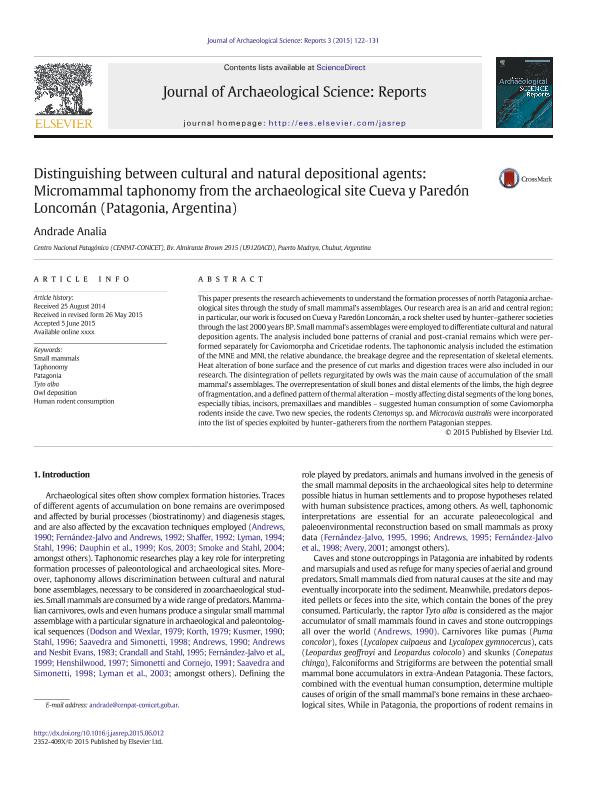Artículo
Distinguishing between cultural and natural depositional agents: Micromammal taphonomy from the archaeological site Cueva y Paredón Loncomán (Patagonia, Argentina)
Fecha de publicación:
06/2015
Editorial:
Elsevier
Revista:
Journal of Archaeological Science: Reports
ISSN:
2352-409X
Idioma:
Inglés
Tipo de recurso:
Artículo publicado
Clasificación temática:
Resumen
This paper presents the research achievements to understand the formation processes of north Patagonia archaeological sites through the study of small mammal's assemblages. Our research area is an arid and central region; in particular, our work is focused on Cueva y Paredón Loncomán, a rock shelter used by hunter–gatherer societies through the last 2000 years BP. Small mammal's assemblages were employed to differentiate cultural and natural deposition agents. The analysis included bone patterns of cranial and post-cranial remains which were performed separately for Caviomorpha and Cricetidae rodents. The taphonomic analysis included the estimation of the MNE and MNI, the relative abundance, the breakage degree and the representation of skeletal elements. Heat alteration of bone surface and the presence of cut marks and digestion traces were also included in our research. The disintegration of pellets regurgitated by owls was the main cause of accumulation of the small mammal's assemblages. The overrepresentation of skull bones and distal elements of the limbs, the high degree of fragmentation, and a defined pattern of thermal alteration – mostly affecting distal segments of the long bones, especially tibias, incisors, premaxillaes and mandibles – suggested human consumption of some Caviomorpha rodents inside the cave. Two new species, the rodents Ctenomys sp. and Microcavia australis were incorporated into the list of species exploited by hunter–gatherers from the northern Patagonian steppes.
Archivos asociados
Licencia
Identificadores
Colecciones
Articulos(CCT-CENPAT)
Articulos de CTRO.CIENTIFICO TECNOL.CONICET - CENPAT
Articulos de CTRO.CIENTIFICO TECNOL.CONICET - CENPAT
Citación
Andrade, Analia; Distinguishing between cultural and natural depositional agents: Micromammal taphonomy from the archaeological site Cueva y Paredón Loncomán (Patagonia, Argentina); Elsevier; Journal of Archaeological Science: Reports; 3; 6-2015; 122-131
Compartir
Altmétricas




